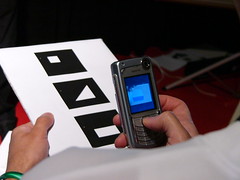Lego's Augmented Reality
Well, everyone has already written about it (where you can find lots of pictures). Lego collaborated with Metaio in order to augment some of its packages in such a way that when looked through a camera, the packages will display the completed Lego model in 3d.From the press release:
The DIGITAL BOX from the LEGO Group comes to the rescue. From November, children great and small can hold special LEGO boxes – containing a hydraulic digger or police station, for example – up to an interactive kiosk and watch a 3D animation of the product inside the box – superimposed on the box. All of this is made possible by metaio’s software, which fuses virtual 3D animations into a live video of the actual product packaging. As a result, buyers can hold both the box and the finished product in their hands. Construction sets are a great match for this technology. Here, metaio’s software not only creates a fascinating technical experience, but gives retailers a unique selling pitch while helping to inform interested buyers. After all, customers get to see exactly how much fun there is inside! The idea has not been termed “smart packaging” for nothing.
This is another sign that augmented reality is creeping its way to the mainstream. Moreover, it's a great opportunity to officially announce about this blog's little competition between the two AR power houses. Starting from 1/1/09 the current score is Metaio: 1, Total Immersion: 0.

